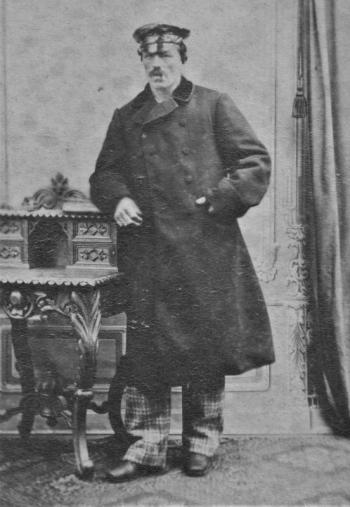An East Boothbay Mariner Goes to China, 1877
In the mid-1830s the village of Hodgdons Mills, now East Boothbay, was being transformed from an extended Murray family farm into a shipbuilding village with multiple shipyards. Most of the arrivals were following the lead of Caleb Hodgdon, who came from Jeremysquam (later Westport) in the mid-1820s. The shipyards spread along the waterfront and new houses snaked along the road and new side roads.
The Hagan family
One of the new arrivals was Miles Hagan. Born in 1814, he moved to Hodgdons Mills from Georgetown, Maine in the mid-1830s and married Jane Murray, a local village girl also born in 1814. She grew up in the classically beautiful Murray house overlooking The Marsh on Murray Hill. Miles devoted himself, not to shipbuilding, but to housebuilding, and there was plenty of that to do in the village. I believe many of the new houses of that era were built by him. He lived in the Andersen house on the corner of Andersen Road, originally a cape, but renovated into a two-story mansard house late in the 1800s. Kitty-corner across Route 96 from there is a house with a sharp gable, now owned by Jack and Holly Fulmer, which Miles built in 1869. I wonder if many of the village houses with those gables were built by Miles. After I gave Holly some pointers in 2006, she did excellent deed and valuation research to determine dates regarding her house.
Miles and Jane had sons Andrew in 1836, Dennis in 1839, Cyrus in 1843; and daughter Rinda in 1845. Dennis and Cyrus enlisted in the Civil War and luckily both came home, as did Rinda's husband James Oliver Seavey. Rinda and James Oliver, a sparmaker and blockmaker in the shipyards, lived in the Andersen house. Brother Dennis was a housebuilder, perhaps with Miles, and he was also was a joiner in the shipyards. He and his wife Lydia lived in the Fulmer house, either with Miles and Jane or after Miles died. I believe Cyrus, unmarried, made his living at sea and may have lived with his parents. He was a fisherman on the 62-foot fishing schooner Nellie M. Short, built in Hodgdons Mills by the Adams family in 1864. During her short career, she was manned almost totally by village men. She went down on the fishing banks in 1869 with six local fishermen: Cyrus Hagan, four Van Horns, and one McDougall captain.
Andrew Hagan on a Tea Clipper
And that leaves Andrew. Perhaps, being a seafaring man, he was in the merchant marine during the Civil War and hence was exempt from serving alongside his brothers. We have letters from Andrew and letters about him in the late 1870s. The tone of his letters and his position as second mate implies he'd spent years at sea.
In July 1877 Andrew wrote his father Miles that, "I have shipted in the Golden State of New York going to Shanghai in China. She is one of the tea clippers trading between New York and China. I suppose we shall be about one year over the voyage." He explained to Miles that he'd had many prior chances to ship out but kept looking for the best wages.
Visiting Old Friends Along the Coast
While in Portland on his way to New York, Andrew visited with Bob Gould, an East Boothbay childhood friend who was head of the blacksmith shop at the well-known Portland Company, a major industrial complex that built locomotives and other heavy machinery and fittings. Andrew had a tour of the machine shop and they rented a team to "sightsee about the town." On the boat to New York, he visited with one of the East Boothbay Poors who was a cook aboard her. I believe this was Oscar Poor, a seafaring man who often served as cook and was shipwrecked repeatedly in his many decades at sea. He had the good fortune to die at a very old age.
Andrew continued, "I suppose Mother has been mourning ever since I left," explaining he hadn't written before since he had no news. He went on, "Tell Den [brother Dennis] that I shall have a chance to get his baby picture painted." He closed by saying, "Give a kiss to Mother. I am writing with a pen that doesn't require ink"—evidently he had an early fountain pen.
The Indian Ocean
More than a year later, on August 11, 1878, Andrew wrote Miles again, "We had a hard passage across the Indian Ocean, had part of our stern washed off and mizzen channels started [mizzen mast sections separating?]. We will stop at Anjier [in Java, now Indonesia] and repair dammages. We are about 60 miles from Java Head. He wrote a little more of shipboard events a few days later, then of home, "Give my love to the Hodgdon girls and tell Hannah that I want her to knit me a half a dozen pairs of socks by the time I get back." Then, "I hope Den got his pitchure." He closed the letter by mentioning his repair work on the stern and with, "We leave tomorrow for China. Love to all."
Next time: Andrew's voyage to China continues.






























